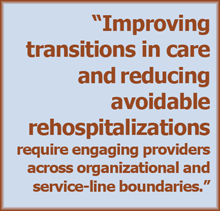Synopsis
The State Action on Avoidable Rehospitalizations (STAAR) initiative fosters partnerships among hospitals and their community-based partners to improve provider communication at critical transitions in patients' care. It also has engaged payers, providers, and employers in statewide efforts to identify and mitigate barriers to well-coordinated care.
The Issue

Avoidable rehospitalizations are a marker of poor-quality care and a leading source of costs in health care. To address this problem, the Affordable Care Act will impose a financial penalty on hospitals with higher-than-expected rates of rehospitalization. Reducing rehospitalization rates, however, also requires significant coordination among the physicians, hospitals, and nursing homes that share in the care of patients but often lack incentives to coordinate that care. Supported by grants from The Commonwealth Fund, the STAAR initiative seeks to reduce 30-day rehospitalization rates statewide in Massachusetts, Michigan, Ohio, and Washington. Writing in Health Affairs, the program leaders reported the results of the statewide mobilization strategy at the mid-point of the four year initiative.
Key Findings
- Nearly 150 STAAR hospitals have joined more than 500 community-based partners, including nursing homes, home health agencies, and physician practices, in "cross-continuum teams." The teams review events associated with rehospitalizations, identify their causes, and develop strategies to address them.
- Among the strategies developed to reduce rehospitalizations are: improving patient education, ensuring timely follow-up with patients after hospital discharge, and creating universal transfer or discharge forms.
- Hospitals participating in Ohio's STAAR initiative contribute to the state funding model, with the promise of reimbursement if they adhere to the initiative's core methodology. This approach has proved successful in encouraging participation: on-time reporting rates were 50 percent higher than in the other (grant-funded) states. This arrangement, the authors note, may serve as useful template for other states.
- One of the common challenges facing STAAR states is data collection, which is complicated by the lack of a standard definition of "rehospitalization." Other challenges include engaging hospital executive teams in performing current and future financial analyses of the impact of readmissions on their operations. This is important, the authors suggest, in creating the necessary short-term and long-term strategies to sustain quality improvements that reduce volume.
Addressing the Problem
Efforts to reduce rehospitalizations, the authors say, must extend beyond the walls of the hospital. Hospitals that face future financial penalties under the Affordable Care Act will find greater success in efforts to reduce rehospitalizations if they meaningfully partner with community providers. Of all the recommendations in the STAAR initiative, the most widely accepted and useful — according to participants and leaders — is the concept of the "cross continuum team."
The Bottom Line
Collaboration among hospitals and community-based providers is essential for improving transitions between care settings and keeping discharged patients out of the hospital. Fostering partnerships among providers, payers, and health plans can help identify causes of avoidable rehospitalizations and align programs and resources to address them.


